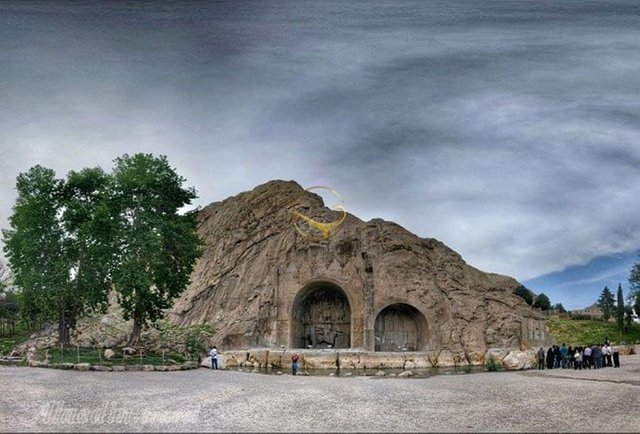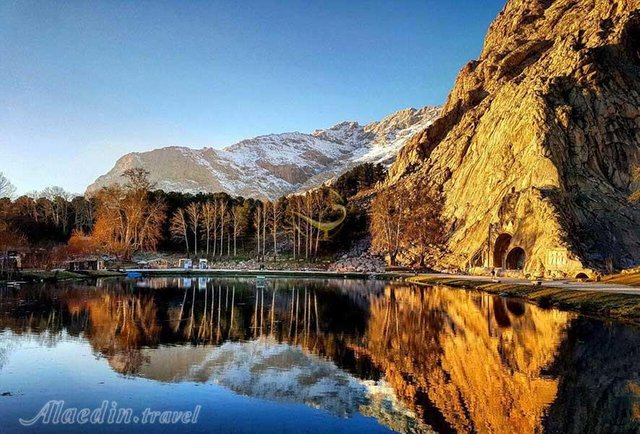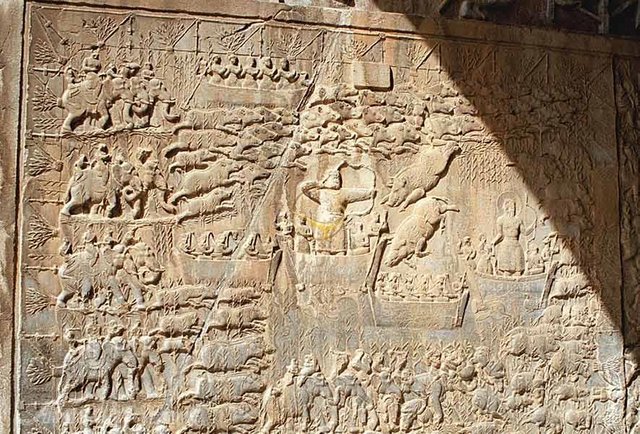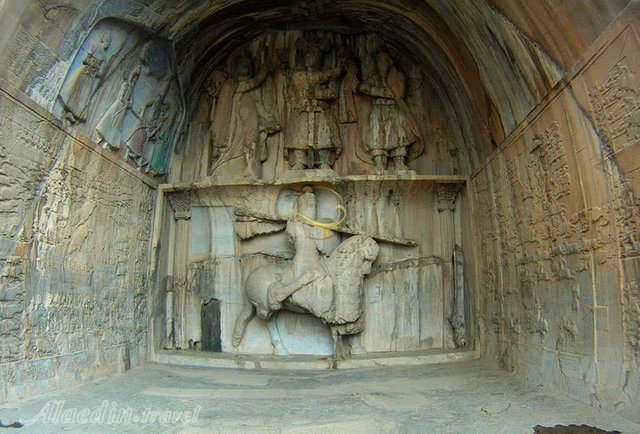Bostan arch

Sometimes seeing maps in the heart of the rock draws you to look at its secrets and mysteries and step into the heart of history. When it comes to the history of Kermanshah, we are reminded of Biston and the Bostan Arch of Kermanshah. An arch that is dug in the heart of the rocks of Kermanshah and attracts tourists to Kermanshah .
A little more about hunting Sassanid
monument of Taq-e Bostan Like many other architectural monuments of the Sassanid in front of lake and pond water is built. Water was an important element in the architecture of that time. In pre-Islamic religions, the lord of the species or the goddess Anahita, the guardian of water, protected the water-scarce land of Iran so that no one would waste this life. In addition, since water was one of the four elements, it played a significant role in Sassanid architecture. If the Sassanid fire temples have the four elements of water, wind, earth and fire in their architecture, they would have built their magnificent buildings inspired by these elements.
As you can see, in front of the arches of this Nakhjirgah (hunting ground), there is a blue lagoon that cleared the hunting ground during the Sassanid era. One of the customs of the Sassanid kings was to go hunting. Hunting was a hobby that kings practiced until the end of the Qajar period. At that time, anyone who was an adult was allowed to hunt. This hunting ground is also mentioned in the poems of the great Iranian poet Hakim Abolghasem Ferdowsi. Sassanid architecture, with its large and extensive arches, showed the greatness of the Sassanid kings, who for years had laid their heads on the ground, and from which the royal glory and splendor of the relief, a few arches remain. This style of architecture developed in post-Islamic Iranian architecture, and architects created unparalleled beauty in buildings using this style. .
What Arab and Iranian historians have quoted about the glorious court of the Sassanids is mostly related to the court of Khosrow Parviz. Next to the cave that Shahpour III dug in the Bostan arch, a much larger cave was built by Khosrow Parviz, whose semicircular arch is in the style of the royal palaces. Parviz's hunting ground was a vast area called Paradise, a place full of all kinds of animals, such as ostriches, gazelles, zebras, peacocks, lions and leopards!

What is the role of Bostan arch inscriptions?
But the arches of Bostan Arch are not only related to hunting, and only part of it is dedicated to hunting. In this arch, the Sassanid kings received the ring of power from Horamzda and were God's representatives on earth. Although the shape and appearance of God are not mentioned in any religious texts and there is no description of God in Zoroastrian texts, but usually the representative or God in the form of a man in a Sassanid dress gives the king a ring of power. There is a remnant of Sassanid Ardashir II who stands in the middle between Ahuramazda and Mitra, receiving the ring of power from God. Here, for the first time in Iran, the relief of Mitra, the goddess of light, is engraved. In this prominent role, Mitra is a man wearing a Sassanid dress. Here at the top of Mitra's head, you can see the rays of the sun, holding a stick that I may have reached and is one of the sticks of Zoroastrianism. Under his feet, the lotus flower is carved, and under the feet of Ahuramazda and Ardeshir Shah, an enemy is buried and killed. .
In a small arch that is 5 meters high, you will see the role of two Sassanid kings, Shahpour II and III. Shapur II was one of the middle Sassanid kings who fought many wars and when the Arabs protested against him, he ordered that his shoulders be pierced. For this reason, he was called the King of Dhu al-Aktaf, which means the owner of two shoulders

The large arch of Bostan arch in Kermanshah is nine meters high. This arch, which is filled with all Sassanid motifs, sees the role of King Khosrow Parviz standing on top of the arch, standing and taking the ring of power from Ahuramazda, which has a human role. Behind her is the water goddess Anahita, who plays the role of a woman. This is one of the few maps of the goddess Anahita that has been carved in the heart of Kermanshah rock. Below this section, at the bottom of the Sassanid cavalry, you can see that it is all armored and has a helmet that covers its face and has a spear in its hand. These reliefs are carved out of the rock and have a three-dimensional form compared to other Sassanid artifacts, which shows the royal art of that time. .
On the walls from below, you can see the role of the king's hunting ground, which shows the location of the no-go hunting for boars and deer. The king has a canopy and a person has an umbrella over his head. On the other side, in a boat with a bow, where the fleeing animal is engraved, the same role is engraved on Sassanid vessels. In this role, hunting on the wall of Bostani arch is another important sign, for example, an ancient instrument called harp, which is in the hands of women musicians and shows the importance of Sassanid kings to music. It is a melodious music that reminds the singers of Khosrow Parviz's court in the solitude of the king who is engraved on the wall and the tone of Nakisa and Barbad. In poetic literature, Khosrow Parviz is one of the most important romantic characters in which Samarkand's prose prose depicts the imaginary love of Khosrow and Shirin in the fantasy world.

The Qajar kings who went to banquets and hunting have reached this important place, and since the Bostan arch and Kermanshah itself have been the relics of many people since ancient times, they have guessed from Ferdowsi's poems that these people are the same kings in the stories of the famous poet. Ferdowsi has come. Fath Ali Shah Qajar, who was always the groom, was very interested in making beds and jewelry. He later became interested in reading Ferdowsi's stories of Sassanid kings in order to have many crowns and important beds. During his trip to Kermanshah, without realizing that this was the role of the Sassanid kings, he left a role in the large arch with his clothes inside the arch on the left, as if he were sitting next to the Sassanid king. This is one of the three famous reliefs of Fath Ali Shah Qajar.
In the exterior of the arch, the leaves and petals of flowers and plants are carved and two angels have rings in their hands.
The best time to visit Bostan Arch is when the
atmosphere of Bostan Arch in spring and summer is pleasant, which entertains the people of Kermanshah and other cities of Iran to have fun next to this historical site.
